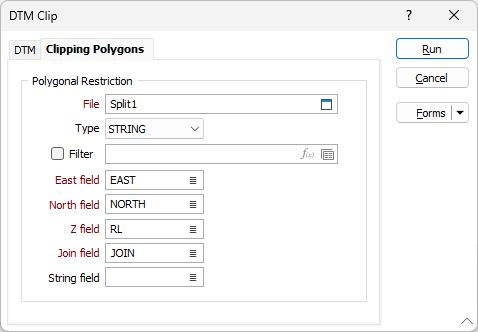Clipping Polygons
Polygonal Restriction
On the Clipping Polygons tab of the DTM Clip form, select a file that contains the polyline(s) used to clip the input DTM.
File
Double-click (or click on the Select icon) to select the file. If required, define a filter to selectively control the records to be processed.
File
For the optimum performance of a DTM Clip operation:
- each cutting polyline should be a closed polygon (however, no warning is displayed for non-closed polygons and these are ignored)
- each cutting polyline should not intersect other polylines on the X-Y plane
To validate the polylines in a file, on the Design tab, in the Utilities group, select General > Condition String.
Filter
Select the Filter check box and open the Filter form to select a filter for the Clipping Polygons data. You can also click the Expression icon and open the Expression Editor to use an expression instead.
East and North and Z fields
Specify the names of the fields in which Easting, Northing, and Z coordinates are stored in the string file.
Join field
In forms that require polylines as an input, the values in this field define whether the data points in the input file should be joined by a line. If successive records have the same value in this field, a line will join the points. If two-factor topology is required, the values in a String field may also be used to segment the lines.
String field
In most forms, the String field is an optional generic attribute used to store a secondary input such as a code. Traditionally, this field has also been used with the Join field to define whether data points should be joined by a line, or strung, hence the name.
